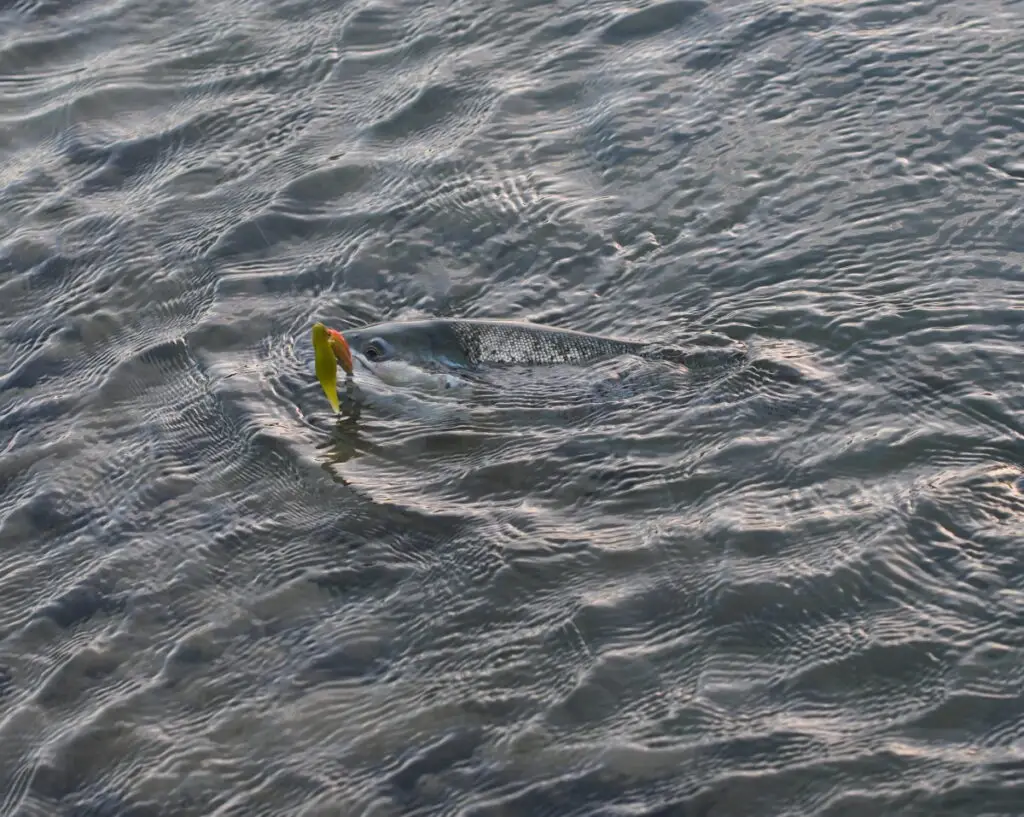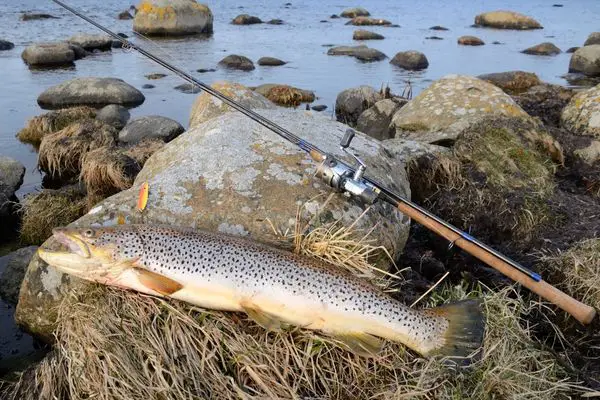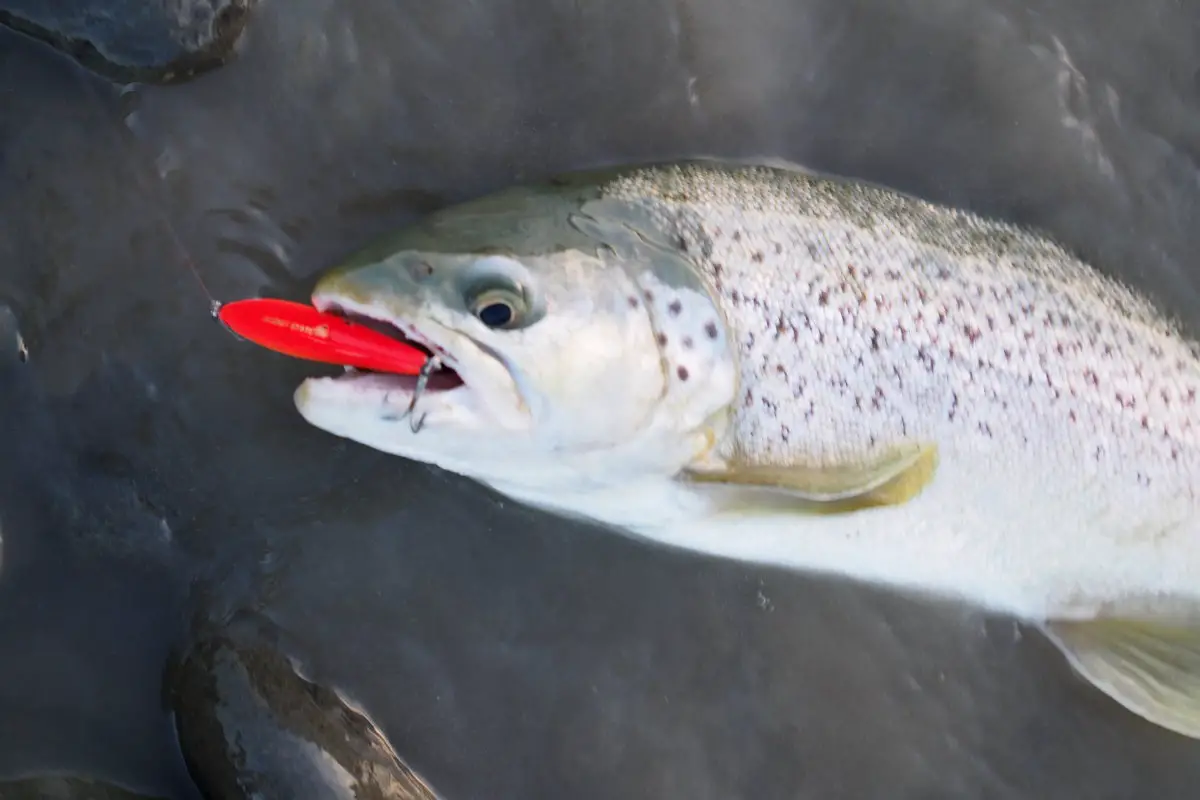As the sun sinks behind the horizon, the only ripple on the vast river flat was some distant fish raising. I stalked my way upriver, restricted to the narrowest margin between tall river reeds and the deeply shelving river. The river bed quickly drops away to chest deep. Maybe more, I did not check.
I cast my Rapala out towards and over a submerged log. I knew its location, the slight current splits and flows around it. My lure hits the water with a slight plod, and I start my retrieve. The Rapala slowly darts and wobbles as it approaches the log. A sudden surge of water and moments later my line tightens and my rod tip bends over. The fight begins.
Sea Run brown trout offers some of the most exciting trout fishing for the spin angler. Sea run trout are often found in large and gently flowing lower portions of rivers. There is a lot of water to cover, and the speed and casting distance of spinning allows a lot of water to be covered in a short amount of time.

When To Target Sea Run Trout?
In my experience, there are Sea run trout in the river most of the year. I suspect many live in the brackish estuary zone and quite frequently move between the sea and river proper.
But the main run of sea trout is typically in the fall, that is when large numbers enter rivers to spawn. After spawning, they will then drop back down to the estuaries to feed and put condition back on from there some will continue out to sea.
Where in the United States to target sea run brown trout?
Sea run brown trout can be caught on both coasts but they are not common.
They are more common in the Northeast between New Jersey to Maine. They also can be caught well into Canada. They can also be found on scattered rivers up the West Coast but in low numbers.
Look for rivers with large brackish estuaries where the trout can feed while acclimatizing to the saltwater environment. They might not be common, but with enough effort and patience, they can be found.
Outside of America, they are plentiful in Northern Europe, Argentina, and New Zealand.
Where to catch sea run brown trout?
Sea trout often gather at river mouths.
Sea run trout can be caught at the river mouth before they enter the river proper. Now, I have always struggled to get consistent catches when casting into the ocean. There is a lot of water to cover, and any trout out there remain very mobile.
To target trout, it is important to cover the entire water column. I make sure to cover the bottom, middle, and even surface. This is different compared to salmon fishing, where you will want to be dragging the lure just off the bottom. That is because Salmon rest in the holes, while the trout keep on the move.
River Mouths are a complex web of currents, bars, and holes. Trout are lazy fish, they dislike wasting energy. So on the outgoing tide, when the river mouth is roaring trout are more likely to position themselves where they can lay and grab food as it moves past. One prime spot to find trout is deeper holes, they are normally a calmer spot at the mouth. They also hold on to the edge of gravel bars. I like to run my lure so it passes just on the edge of the current and still water.
If fishing a floating lure, it is at times possible to let the current carry it far out to sea. Then you can wind it back in. That can allow for much longer casts.
Mostly, I do not fish coastal river mouths for trout; I target other species and the trout are more a nice surprise that I catch from time to time. Trout, including sea runs, are much easier to catch further upstream than at the mouth.
Sea run brown trout often hold at the first riffle.
Sea run trout often concentrate around the first riffle or rapid in a river. Basically where the freshwater meets the brackish water. In deep, slow flowing rivers this can easily be several miles upstream from where the river joins the sea proper.
In steeper rivers, it might only be a hundred yards from the mouth itself.
The location of the riffle also moves with the tide. But generally, the riffles are easier to locate at low tide when there is less water in the river. The incoming tide, can force the freshwater upstream submerging shallow rapids and ripples.
It is also worth looking at the riverside vegetation. Some species like willows are not very salt tolerant, so only will grow once the water is mostly fresh.
Fish the pool beneath the first riffle
I like to break the riffle into several sections. At the bottom of the riffle, there is normally a deeper pool. Trout and salmon often concentrate there, the salmon are resting, while the trout are feeding. These pools can be deep, so I suggest fishing a deep diving or heavy lure and fishing near the bottom. This is also a prime spot for night fishing.
Target the edges for trout holding out of the current
Trout often feed along the shallows on either side of a riffle. In the tidal sections of rivers, riffles are often overlooked. Trout feed there because the water current is normally slowest towards the shore. Smaller baitfish often swim there when they are trying to push upstream. The trout know that, so they lay in wait to ambush any shoals moving through. These trout are in a feeding mood, so can be quite easy to catch.
Fish around, behind, and in front of structure
This might be trout fishing 101, trout love to hold near structure and sea trout are no different.
Submerged branches and logs are ideal spots to look for holding sea run trout. They position themselves there keeping out of the flow of the current.

Where to find sea trout upriver?
When fishing further upriver out of the tidal influence I do not specifically target sea run. That is because their holds are going to be the same as the resident trout. One cast I can catch a sea trout, and the next a resident.
In my experience, the spinning methods which work well on the resident fish will also catch any sea run which have moved further up the river.
The further up the river the sea run trout travel the more their diet changes to the food available in the river.
Targeting sea trout on the spawning run?
In the fall and early winter, a large number of trout leave the sea and the brackish lower estuaries and push upstream to spawn.
These trout, are thinking about spawning, not feeding and they can become difficult to catch.
When targeting such trout, aim to get a strike out of aggression rather than hunger. Try and piss them off with a loud or obnoxious lure. Inline spinners work great.
By mid-winter, spawning should be over and there should be a bunch of weak and wary trout slowly heading back downstream. These trout are hungry and often feed aggressively. Some even stay behind in the spawning streams to steal eggs.
Best lures and spinners for Sea Run trout in the river.
My preference for spinning lures depends more on where in the river I am fishing. In the lower tidal sections of the river. When fishing upriver, I usually use minnow lures such as I have written a guide on trout fishing with jerkbaits here. Lifelike patterned lures with realistic action work well in still water. Trout have time to inspect the prey before striking.
My favorite colors depend largely on water conditions. My go to lure is often a brown trout pattern floating Rapala in about f7 size (Sea run trout are not afraid of larger lures). When conditions are clear and sunny, I like to use a herring pattern, with a blue back and silver body. In cloudy or discolored water, I have had good luck on very bright obnoxious lures. I love bright orange, but I know other anglers who do well on nuclear chicken. Just something to stand out among the murk.
Upriver, in the rapids and riffles I change to an in-line spinner. The exact brand of in-line spinner I fish really depends on the depth and speed of the water. Basically, fast deep water I like Blue Fox, and slower water Panther Martins but I use a wide variety of different brands. I have no loyalty. If you want to know more on how and where I fish different in-line spinners check my guide here.
I like the traditional colors, mostly being silver, gold, black and red/orange or blue. The combination of flash and vibration works well when fishing through moving water.
Best lures for targeting sea run trout in the sea?
When casting out to sea, distance is everything. One of the most popular and best lures to try is the kastmaster or other hex lures. They cast like a bullet and cover a lot of distance. Best of all they are easy to find in most fishing stores.
There are other options, Over in Europe where targeting sea trout is popular. The Danes use highly specialized line thru lures. These long streamline lures cast like a bullet, and because the line runs independently of the lure the trout it is harder for the trout to throw the hook.
Unfortunately, I have never seen these lures for sale in North America. So for the time being, Kastmasters likely remain the best option.
Best Spinning rods and reels for sea run brown trout fishing
When fishing upriver, I mostly just use my normal trout setup. A 2500 size reel and an ultralight rod.
Although, when the big fish are in the river I sometimes go up a size. With regards to fishing line, I usually fish 6lb when targeting sea run fish. While 4lb line might be fine for catching stock trout, a 12lb sea run can push such gear to its limit. It just gives slightly more margin for error.
It is a bit of a different story when fishing off the beach into the sea proper. Down there I use heavier tackle, rated for 6-12lb. So more a medium-light rod than an ultralight rod. That is because I cast heavier lures that fly further and can really punch into the wind. The thicker line also adds a degree of abrasion resistance.
I personally use a beautiful 7ft USA made Shakespeare rod which I found on the clearance rack about 15 years ago. It must of been one of the last American made rods from the company. It is a beautiful blank but sadly discontinued.
If I need to recommend a rod currently available, the medium-weight 7ft Ugly Stick elite is tempting, but I might go for a 7’6″ rod for slightly more distance on my cast. It has a stiff enough base and loads quite nicely when casting heavier lures. Best of all it does not break the bank/. Some dedicated fishermen do use even longer rods but I prefer the lightness of a 7fter.
My go-to reel for chasing sea run trout is the Shimano Stradic FL 2500, but sometimes I use an old Abu Garcia Soron 40. It is the same gear I use when targeting steelheads. I love the Stradic due to its combination of refined toughness and excellent corrosion resistance.
If on a budget, the Penn Battle III offers excellent value for under $100. I have reviewed both reels in our Spinning reel buyers guide.

